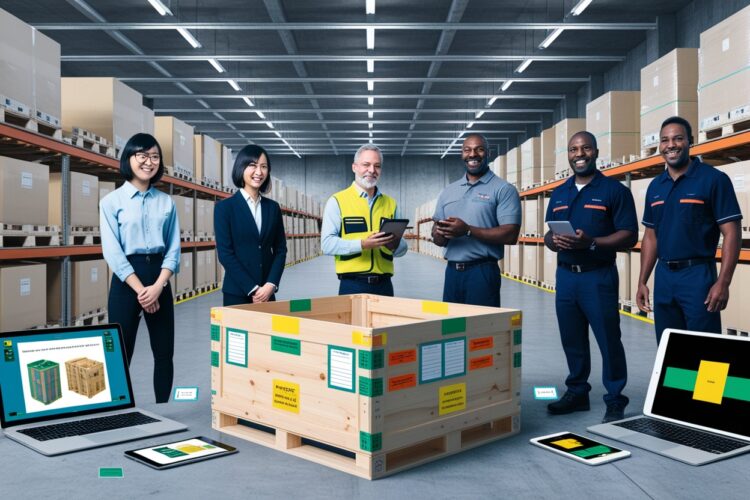The Role of Image Annotation in Logistics Management
The Role of Image Annotation in Logistics Management
In the fast-paced world of logistics, efficiency, accuracy, and automation play a crucial role in ensuring smooth operations. Image annotation, a key aspect of artificial intelligence (AI) and machine learning (ML), has emerged as a game-changer in logistics management. By leveraging image annotation techniques, logistics companies can enhance tracking, optimize warehouse management, streamline delivery processes, and improve overall operational efficiency.
1. Enhancing Automated Tracking Systems
Image annotation enables AI-driven tracking systems to accurately identify and classify packages, containers, and vehicles. Annotated images help in training computer vision models to recognize barcodes, QR codes, and other identifiers, reducing human intervention and minimizing errors in tracking shipments. This ensures real-time visibility across the supply chain, improving transparency and accountability. Additionally, AI-powered systems can predict delays and reroute shipments accordingly, minimizing disruptions and ensuring timely deliveries.
2. Optimizing Warehouse Management
In warehousing, efficiency is key to meeting demand and reducing costs. Image annotation helps automate inventory management by enabling AI-powered vision systems to identify, count, and categorize items stored in warehouses. Datasets with annotated images assist in training robots for automated picking, sorting, and stacking, significantly improving warehouse operations and reducing human workload. Moreover, AI-powered warehouse management systems can detect misplaced or missing items, ensuring better stock control and minimizing losses.
3. Improving Quality Control and Damage Detection
Image annotation plays a crucial role in quality control by allowing AI models to detect defects, damages, or irregularities in goods before they reach customers. By annotating images of products at various stages of transit, logistics companies can automate the identification of damaged items, ensuring only high-quality goods are shipped to end-users. AI-powered inspection systems can also assess packaging integrity, preventing potential product losses due to poor handling or inadequate packaging.
4. Enhancing Route Optimization and Traffic Management
Logistics companies rely on AI-based route optimization to minimize delivery time and fuel consumption. Annotated images from traffic cameras, satellite imagery, and vehicle-mounted sensors help AI models analyze road conditions, congestion, and obstacles. This data enables better route planning, reducing delays and enhancing last-mile delivery efficiency. Furthermore, AI systems can integrate real-time weather data, road closures, and historical traffic patterns to predict the best possible routes.
5. Enabling Automated Vehicle Management
The integration of image annotation in logistics extends to fleet management. AI-powered vehicle monitoring systems use annotated images to track vehicle conditions, detect maintenance issues, and ensure compliance with safety standards. This proactive approach helps in reducing downtime and operational disruptions. With predictive maintenance, logistics companies can schedule repairs before breakdowns occur, preventing costly delays and improving vehicle longevity.
6. Enhancing Security and Fraud Detection
Security is a major concern in logistics, and image annotation helps mitigate risks related to theft and fraud. AI models trained with annotated security camera footage can detect suspicious activities, unauthorized access, and cargo tampering. This enhances security measures and ensures the safety of goods in transit. Additionally, AI-driven facial recognition and motion detection systems can help in monitoring restricted areas, preventing unauthorized access to storage facilities and vehicles.
7. Automating Sorting and Labeling Processes
Manual sorting and labeling of packages can be time-consuming and prone to errors. Image annotation helps AI-powered systems automate these processes by accurately identifying package labels, shipping details, and categorization marks. This leads to faster and more efficient logistics operations, reducing labor costs and improving overall productivity.
8. Improving Customer Experience
Customer satisfaction is a key metric for logistics companies, and AI-driven image annotation can enhance user experience by providing real-time shipment tracking, faster deliveries, and accurate estimated arrival times. Automated damage detection ensures customers receive products in perfect condition, reducing return rates and increasing trust in logistics services.

Conclusion
Image annotation is revolutionizing logistics management by enhancing automation, accuracy, and efficiency across various processes. From automated tracking and warehouse optimization to quality control, security, and route planning, AI-driven image annotation provides logistics companies with powerful tools to improve operations and reduce costs. As AI and ML technologies continue to evolve, the role of image annotation in logistics will only become more significant, paving the way for a smarter and more efficient supply chain. Investing in AI-powered image annotation can give logistics companies a competitive edge, ensuring smooth, efficient, and secure transportation of goods worldwide.


